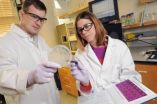(Press-News.org) From sore feet to backaches, blame it on human evolution.
"Because we are the only mammals to walk on two feet," says Bruce Latimer, an anthropologist from the Case Western Reserve University School of Dental Medicine.
Latimer will present "A Backache of Longstanding: An Evolutionary Perspective on the Human Vertebral Column" at the 2013 American Association for the Advancement of Science's annual meeting in Boston, Feb. 14-18. His talk will be featured in the session, "The Scars of Human Evolution."
Latimer and other panelists will explain how adapting to upright walking has resulted in physical challenges that affect most humans. A news briefing at 10 a.m. is scheduled on Friday, Feb. 15, in Room 103, Hynes Convention Center and precedes afternoon talks in Room 302, also in the center.
"If an engineer were given the task to design the human body, he or she would never have done it the way humans have evolved," Latimer said. "Unfortunately, we can't go back to walking on four feet. We've undergone too much evolutionary change for that—and it is not the answer to our problems."
But applying Darwinian evolutionary theory to the human condition offers a window to why humans suffer from physical ailments that no other animals do, said Latimer, who is on the faculty in the Department of Orthodontics at Case Western Reserve.
Evolving from four-footed walking has created issues from flat feet and bunions to slipped discs, hernias and fallen pelvic floors. And as bizarre as it sounds, rising from four to two feet resulted in reshaping the face and head, which is why humans suffers with such dental problems as wisdom teeth with no room to grow.
Latimer's talk will focus on physical problems of the spine, which developed into an S-shaped structure as humans shifted from quadrapedal walking to bipedal walking. But changes to the spine also resulted in protecting the body's most important area, the birth canal, which allowed the species to procreate.
As the spine developed in curves, it became stressed at certain points, resulting in such conditions as lordosis (swayed backs), kyphosis (rounded upper back or hunch back) and scoliosis (sideway curve).
The spine also takes a beating from how people walk—one foot forward at a time with the opposite side arm swinging in step.
"This creates a twisting motion that, after millions of twists over time, the discs between the vertebrae begin to wear out and break down resulting in herniated discs. In addition, age related bone loss (osteoporosis, the brittle bone disease, ) also a human condition, further complicates problems, Latimer explained.
Few early species of ancient human hominids lived beyond 50 years. Most died between 30 and 40, Latimer said. The human body really takes a physical beating, and most people will struggle with some kind of pain as the body ages.
"The original design specs for the human body were designed to last about 40 years," he said.
Other talks in "The Scars of Human Evolution" session include Rachel Caspari from Central Michigan University on the consequences of living longer; Jeremy DeSilva, Boston University, on problems with the human feet; Alan Mann, Princeton University, on the evolution of head and jaw; and William Leonard, Northwestern University, on nutritional health and evolution. Caspari and Karen Rosenberg, University of Delaware, organized the panel. Responding to the talks will be Milford Wolpoff, University of Michigan, and Matt Cartmill, Boston University.
### END
'The Scars of Human Evolution' briefing explores physical fallout from 2-footed walking
2013-02-15
ELSE PRESS RELEASES FROM THIS DATE:
The science of uncertainty in genomic medicine
2013-02-15
BOSTON - The notion of "personalizing" health care through the use of an individual's genetic code has attracted considerable enthusiasm and investment. Impressive examples, confirmed through formal studies of clinical validity and utility, suggest that we have only scratched the surface of applications to treat disease more precisely, identify risk factors for complex disease, and guide preventative measures.
As the cost of sequencing entire genomes falls, the opportunities for people around the world to take possession of their entire genetic code will proliferate. ...
Artificial platelets could treat injured soldiers on the battlefield
2013-02-15
When it comes to healing the terrible wounds of war, success may hinge on the first blood clot – the one that begins forming on the battlefield right after an injury.
Researchers exploring the complex stream of cellular signals produced by the body in response to a traumatic injury believe the initial response – formation of a blood clot – may control subsequent healing. Using that information, they're developing new biomaterials, including artificial blood platelets laced with regulatory chemicals that could be included in an injector device the size of an iPhone. Soldiers ...
NIH study shows big improvement in diabetes control over past decades
2013-02-15
More people are meeting recommended goals in the three key markers of diabetes control, according to a study conducted and funded by the National Institutes of Health and the Centers for Disease Control and Prevention.
The report, published online February 15 in Diabetes Care, shows that, from 1988 to 2010, the number of people with diabetes able to meet or exceed all three of the measures that demonstrate good diabetes management rose from about 2 percent to about 19 percent. Each measure also showed substantial improvement, with over half of people meeting each individual ...
Climate change's costly wild weather consequences
2013-02-15
CHAMPAIGN, Ill. — Throughout 2012, the United States was battered by severe weather events such as hurricanes and droughts that affected both pocketbooks and livelihoods. Research suggests that in the coming years, U.S. five-day forecasts will show greater numbers of extreme weather events, a trend linked to human-driven climate change.
Donald Wuebbles, a professor of atmospheric sciences at the University of Illinois at Urbana-Champaign, will discuss extreme weather in a presentation Feb. 15 at the annual meeting of the American Association for the Advancement of Science ...
Scientists find promising new approach to preventing progression of breast cancer
2013-02-15
LA JOLLA, CA – February 15, 2013 – Doctors currently struggle to determine whether a breast tumor is likely to shift into an aggressive, life-threatening mode—an issue with profound implications for treatment. Now a group from The Scripps Research Institute (TSRI) has identified a mechanism through which mitochondria, the powerhouses of a cell, control tumor aggressiveness. Based on their findings, the team developed a simple treatment that inhibits cancer progression and prolongs life when tested in mice.
The research team, which describes its results February 15, 2013, ...
Study finds that 'Big Pharma' fails at self-policing ED drug advertising
2013-02-15
CHARLOTTE, N.C. –Feb. 14, 2013– The pharmaceutical industry's efforts to self-regulate its direct-to-consumer (DTC) advertising are "an industry-sponsored ruse," intended to deflect criticism and collectively block new Federal regulation, a study released today in the Journal of Health Politics, Policy and Law found.
The paper, "The Politics and Strategy of Industry Self-Regulation: The Pharmaceutical Industry's Principles for Ethical Direct-to-Consumer Advertising as a Deceptive Blocking Strategy," was written by Denis Arnold, Associate Professor of Management and Surtman ...
Avoiding virus dangers in 'domesticating' wild plants for biofuel use
2013-02-15
In our ongoing quest for alternative energy sources, researchers are looking more to plants that grow in the wild for use in biofuels, plants such as switchgrass.
However, attempts to "domesticate" wild-growing plants have a downside, as it could make the plants more susceptible to any number of plant viruses.
In a presentation at this year's meeting of the American Association for the Advancement of Science, Michigan State University plant biologist Carolyn Malmstrom said that when we start combining the qualities of different types of plants into one, there can be ...
Breast cancer risk prediction model for African American women underestimates risk
2013-02-15
(Boston) – A breast cancer risk prediction model developed for African Americans tends to underestimate risk in certain subgroups, according to a new study from the Slone Epidemiology Center (SEC) at Boston University. The model predicted estrogen receptor (ER)-negative breast cancer, which is a more aggressive form of breast cancer that disproportionately affects African American women, more poorly than ER-positive breast cancer.
The study, published online today in the Journal of the National Cancer Institute, was led by Deborah Boggs, ScD, postdoctoral associate at ...
Neuronal activity induces tau release from healthy neurons
2013-02-15
HEIDELBERG, 15 February 2013 – Researchers from King's College London have discovered that neuronal activity can stimulate tau release from healthy neurons in the absence of cell death. The results published by Diane Hanger and her colleagues in EMBO reports show that treatment of neurons with known biological signaling molecules increases the release of tau into the culture medi-um. The release of tau from cortical neurons is therefore a physiological process that can be regulated by neuronal activity.
Tau proteins stabilize microtubules, the long threads of polymers ...
University of Waterloo researchers propose breakthrough architecture for quantum computers
2013-02-15
WATERLOO, Ont. (Thursday, Feb. 14, 2013) A team of researchers at the University of Waterloo's Institute for Quantum Computing has proposed a new computational model that may become the architecture for a scalable quantum computer.
In a paper to be published in the journal Science this week, the research team of IQC Associate Professor Andrew Childs, post-doctoral fellow David Gosset and PhD student Zak Webb proposes using multi-particle quantum walks for universal computation. In a multi-particle quantum walk, particles live on the vertices of a graph and can move between ...


